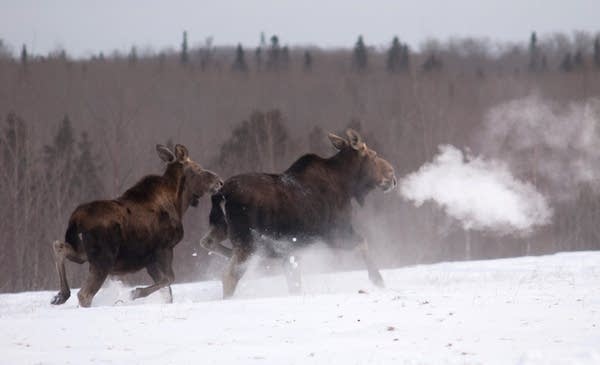DNR: NE Minnesota moose population stable but still worrisome

Go Deeper.
Create an account or log in to save stories.
Like this?
Thanks for liking this story! We have added it to a list of your favorite stories.
Northeastern Minnesota's moose population remains stable but at a relatively low level, and the animals' long-term survival remains uncertain.
Those are the key findings from the Minnesota Department of Natural Resources annual moose survey. It's the eighth consecutive January where researchers found stability in the herd.
Survey results estimate northeastern Minnesota's moose population at 4,180, statistically unchanged from 2018's estimate of 3,030, the DNR said, adding the results reflect a 90 percent certainty that the moose population is between 3,250 and 5,580 animals.
Officials, though, were holding back on the applause.
Turn Up Your Support
MPR News helps you turn down the noise and build shared understanding. Turn up your support for this public resource and keep trusted journalism accessible to all.
"We're encouraged that the moose population is not in the steep decline it was," Glenn DelGiudice, DNR moose and deer project leader said in a statement Monday as the survey results were released. "In the short to medium term, we're likely to keep seeing moose in the forests, lakes and swamps of northeastern Minnesota. But their long-term survival here in Minnesota remains uncertain."
Since the DNR began its modern moose surveys in 2005, northeastern Minnesota's moose population was at its highest in 2006, when survey results estimated 8,840 animals. The last significant population decline occurred between 2009 and 2012.
"We know from our research that adult female moose are getting pregnant," DelGiudice said. "The problem is there aren't enough female moose that are successfully producing calves and raising them to one year. That's a significant challenge in our efforts to maintain Minnesota's moose population."
Calf survival from birth in spring to January continues to be relatively stable but consistently low. Field studies have indicated that survival rates are even lower by spring, translating to low numbers of moose calves living through their first year. DNR research also shows that wolves account for about two-thirds of the calf deaths.
This year's survey involved flying in 52 survey plots distributed across northeastern Minnesota's moose range from Jan. 3 to Jan. 17.


